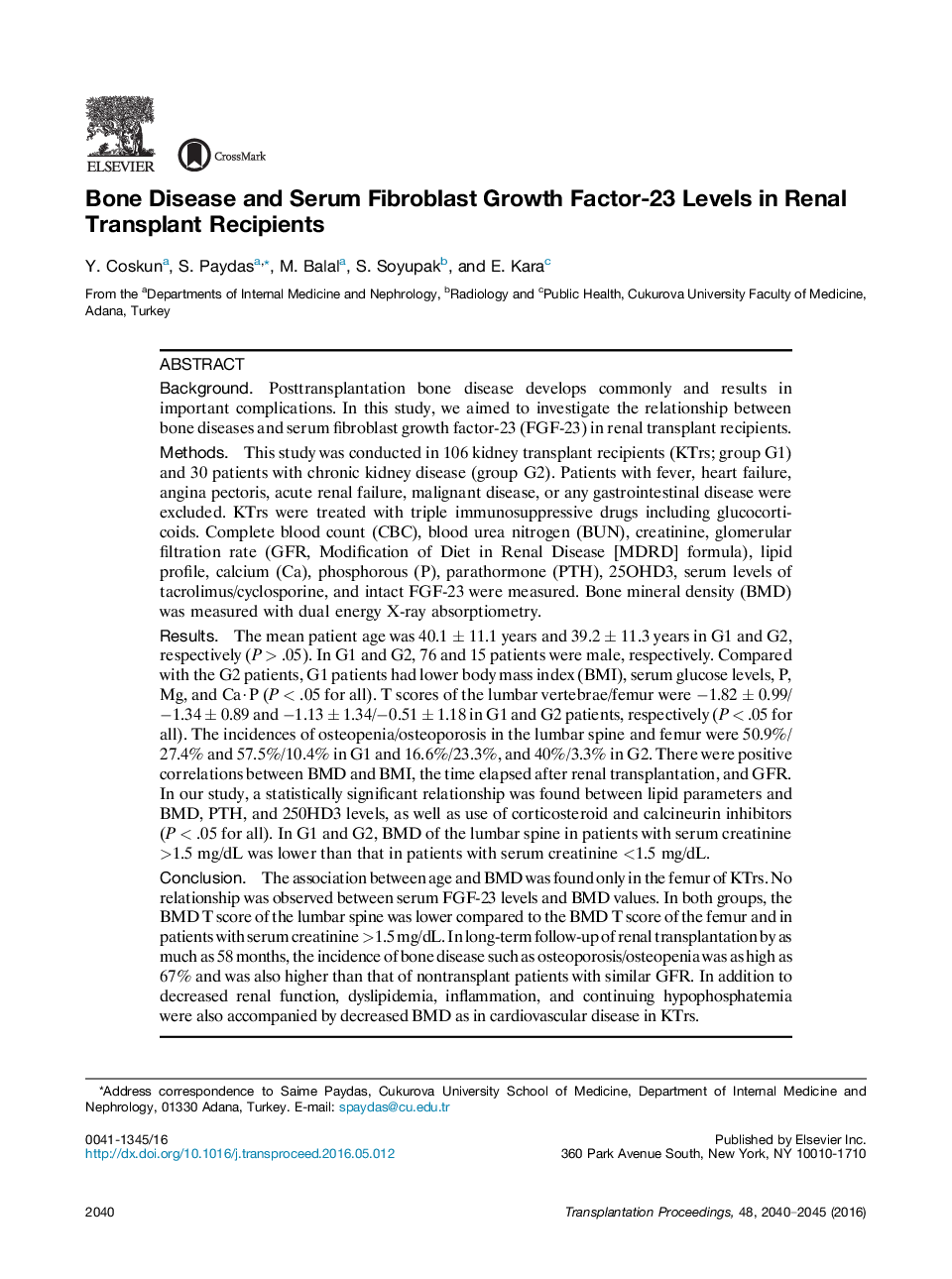| Article ID | Journal | Published Year | Pages | File Type |
|---|---|---|---|---|
| 5729141 | Transplantation Proceedings | 2016 | 6 Pages |
â¢Posttransplantation bone disease commonly develops and results in important complications; in this study, we investigated the relationship between bone diseases and serum fibroblast growth factor-23 in renal transplant recipients.â¢In long-term follow-up of renal transplantation, the incidence of bone disease such as osteoporosis/osteopenia was higher as 67% in renal transplant recipients and also higher than that of nontransplant patients with similar glomerular filtration rates.â¢In addition to decreased renal function, dyslipidemia, inflammation, and continuing hypophosphatemia, decreased bone mineral density, and cardiovascular disease were noted in kidney transplant recipients.
BackgroundPosttransplantation bone disease develops commonly and results in important complications. In this study, we aimed to investigate the relationship between bone diseases and serum fibroblast growth factor-23 (FGF-23) in renal transplant recipients.MethodsThis study was conducted in 106 kidney transplant recipients (KTrs; group G1) and 30 patients with chronic kidney disease (group G2). Patients with fever, heart failure, angina pectoris, acute renal failure, malignant disease, or any gastrointestinal disease were excluded. KTrs were treated with triple immunosuppressive drugs including glucocorticoids. Complete blood count (CBC), blood urea nitrogen (BUN), creatinine, glomerular filtration rate (GFR, Modification of Diet in Renal Disease [MDRD] formula), lipid profile, calcium (Ca), phosphorous (P), parathormone (PTH), 25OHD3, serum levels of tacrolimus/cyclosporine, and intact FGF-23 were measured. Bone mineral density (BMD) was measured with dual energy X-ray absorptiometry.ResultsThe mean patient age was 40.1 ± 11.1 years and 39.2 ± 11.3 years in G1 and G2, respectively (P > .05). In G1 and G2, 76 and 15 patients were male, respectively. Compared with the G2 patients, G1 patients had lower body mass index (BMI), serum glucose levels, P, Mg, and Ca·P (P < .05 for all). T scores of the lumbar vertebrae/femur were â1.82 ± 0.99/â1.34 ± 0.89 and â1.13 ± 1.34/â0.51 ± 1.18 in G1 and G2 patients, respectively (P < .05 for all). The incidences of osteopenia/osteoporosis in the lumbar spine and femur were 50.9%/27.4% and 57.5%/10.4% in G1 and 16.6%/23.3%, and 40%/3.3% in G2. There were positive correlations between BMD and BMI, the time elapsed after renal transplantation, and GFR. In our study, a statistically significant relationship was found between lipid parameters and BMD, PTH, and 250HD3 levels, as well as use of corticosteroid and calcineurin inhibitors (P < .05 for all). In G1 and G2, BMD of the lumbar spine in patients with serum creatinine >1.5 mg/dL was lower than that in patients with serum creatinine <1.5 mg/dL.ConclusionThe association between age and BMD was found only in the femur of KTrs. No relationship was observed between serum FGF-23 levels and BMD values. In both groups, the BMD T score of the lumbar spine was lower compared to the BMD T score of the femur and in patients with serum creatinine >1.5 mg/dL. In long-term follow-up of renal transplantation by as much as 58 months, the incidence of bone disease such as osteoporosis/osteopenia was as high as 67% and was also higher than that of nontransplant patients with similar GFR. In addition to decreased renal function, dyslipidemia, inflammation, and continuing hypophosphatemia were also accompanied by decreased BMD as in cardiovascular disease in KTrs.
